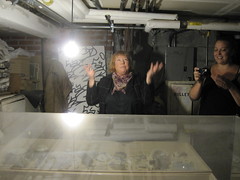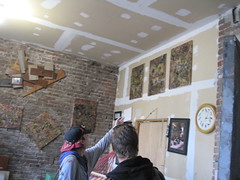A couple of weeks ago, the founders of the Museum of Reclaimed Urban Space told The Local they had started hosting “spontaneous tours” of squats and community gardens. This past weekend, we joined just such a tour, as longtime squatter activist Frank Morales took visitors on a winding, nearly three-hour journey through the interiors of four urban homesteads.
Standing outside C-Squat, where MoRUS is to be housed, Mr. Morales described homelessness as “the consequence of state repression.”
“That was the point of entry for our taking buildings – to create communities of self defense, to defend against being forcibly moved into the shelter system,” he said.
Homesteaders recalled the raucous days of the late 1980s, when squatters controlled as many as two dozen East Village and Lower East Side buildings.
 Jared Malsin Bullet Space member Maggie Wrigley shows 19th century artifacts found on the grounds of the squat.
Jared Malsin Bullet Space member Maggie Wrigley shows 19th century artifacts found on the grounds of the squat.Inside of his light, airy apartment at Bullet Space – a building on Third Street now owned by its residents where the Tennessee Williams play “In the Bar of a Tokyo Hotel” is currently playing in the performance space – Rolando Politi, a 68-year-old Italian-born artist who makes colorful artwork out of discarded objects, reminisced about the days when East 13th Street was a squatter stronghold where activists siphoned electricity from light poles.
“We had parties all night in this crack house, also as a fundraiser for this building,” he told the group while sixties soul music played quietly from a radio. (In the video below, the artist describes a visit from Los Lobos.)
Mr. Politi also recalled the summer of 1995, when the Police Department sent riot police and even an armored personnel carrier to remove squatters who barricaded themselves inside two buildings on East 13th Street. Flipping through a large scrapbook of photos and press clippings, Mr. Politi said, “We came back with our own tanks. I spent the whole summer building tanks. I called it a tank-full summer.”
“The police took one of the little tanks and they wouldn’t give it back to me. It was like a trophy for them,” he added. “They kept it in the police station, so I had an art opening across the street from the police station, so when people wanted to see the art, I sent them inside the precinct.”
Even in the eighties, though, not all the squats were completely anarchic. “Each building also kind of had its own personality,” said Steven Prestianni, 52, speaking to the tour while sitting on the floor of his small apartment in the squat at 209 East Seventh Street. “This building was the quiet, low-key building where people just wanted to try to get the work done, rehab the building, bring it up to code, didn’t want any banners out front and whatnot. Whereas a lot of the other buildings were really rambunctious and proud and waving the squat flag out front.”
The last stop on the tour was another legalized squat, Umbrella House, which features a renovated ground-floor meeting room, bicycle storage, and a rooftop garden with a view of the Manhattan skyline.
This urbane building concealed the strangest stop on the entire tour: an apartment inhabited by a woman who gave her name as Siobhan Meow, 55, and her 23 cats. She explained that she rescues street cats and claimed that at one point in 2001 she housed more than 100 felines in her apartment.
Ms. Meow also showed the tour a series of paintings she had created out of cat excrement. The cats do their business on canvasses that she lays on the floor, she said, and then she works on the canvasses like a painter.
In spite of the odd turn at the end of the tour, participants were enthusiastic. After spilling out of Umbrella House onto Avenue C, one participant, Rachel Cogger, 33 of Sydney, Australia, said the tour “breaks any preconceived ideas of the squatter community.”
She also said, “You’ve got an idea or a notion in your head that it will be a certain way, or people living in quite desolate situations, and it’s a total home. It’s fascinating. There’s a sense of community amongst them as well. It’s really special.”





